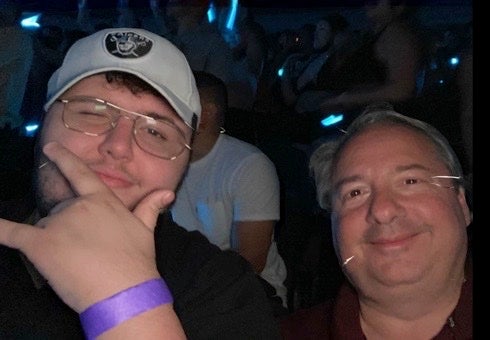Son turned down father’s offer for ‘bucket list’ trip on doomed Titanic sub over safety fears
‘Dude, this submarine cannot survive going that deep in the ocean,’ Sean Bloom says he told his father
A 20-year-old man who had a lucky escape from the doomed Titanic sub disaster has revealed how he turned down his father’s offer of a “bucket list” trip because he feared the vessel wasn’t safe.
Sean Bloom, 20, told People that he and his financier father Jay Bloom almost signed up to join OceanGate Expeditions’ tourist trip to visit the Titanic wreckage.
But, Mr Bloom said that he ultimately refused to go because he wasn’t convinced the Titan submersible would be able to withstand the pressure around 13,000 feet deep in the Atlantic Ocean.
Follow the latest updates on the missing Titanic submarine here
“The whole reason my dad didn’t go was because I told him, ‘Dude, this submarine cannot survive going that deep in the ocean,’” Sean told People.
“I was worried because I didn’t think the submarine could withstand that kind of pressure and it wasn’t meant to go that far.”
He added: “That is a small submarine, with five people crammed inside. It just felt super unsafe. Something was telling me this was not the move.”
Ultimately, the Blooms decided against the trip and the final two seats were snapped up by a different father and son duo: Shahzada and Suleman Dawood.
Tragically, the Dawoods perished alongside British billionaire Hamish Harding, prominent French diver Paul-Henri Nargeolet and OceanGate CEO Stockton Rush when the Titan sub imploded around 105 minutes into what was supposed to be a once-in-a-lifetime journey.

Mr Bloom said that it’s “crazy” to think how the Dawoods were “in a similar situation as me and my dad”, only for the Blooms’ lives to be spared by their decision to turn down the trip.
“I made the informed decision not to do this,” he said.
“I told [my father] it was a bad idea, and he listened to me and we both agreed not to go.”
The 20-year-old told People that one of the first red flags came when Rush flew out to visit his father in Las Vegas.
The entrepreneur travelled to Sin City on a plane he had built himself. While Rush was proud of this, this sent alarm bells ringing for Mr Bloom.
“He’s like, ‘Yeah, I built this plane with my hands, and I’m test-flying it right now.’ And we’re like, ‘What?’ That was my first red flag,” he said.
When he researched the submersible, his concerns grew further, the 20-year-old said.
What he expected was a submarine similar to that used by Titanic discoverer Robert Ballard but, instead, he learned the sub was operated with a video game controller.
“The equipment they were using to go down there, these were massive submarines that were able to handle the pressure,” he said.
“And the submarine Stockton was using just did not look at all ready. I just saw a bunch of red flags at the project. It didn’t seem like a safe operation. And now all this is coming out about how it wasn’t.”
Jay Bloom told People that Rush had tried to put their concerns over the sub’s safety to bed.
“He basically told me he knew I’m a helicopter pilot, and he said, ‘This is safer than flying a helicopter. It’s safer than scuba diving.’ And at lunch he said, ‘It’s safer than crossing the street,’” he said.
“He was a good guy, great heart, really believed in what he was doing and saying. But he didn’t want to hear anything that conflicted with his world view, and he would just dismiss it.
“He absolutely believed what he was saying. But I didn’t want to get into the safety concerns anymore, because he was so vested in his position. And anybody who questioned it just had a differing opinion.”
He added: “He drank his own Kool-Aid.”

Text messages, posted on social media, reveal that Rush tried hard to convince the father and son to join the expedition by offering them each a $100,000 discount on the $250,000 trip.
“There hasn’t been even an injury in 35 years in a non-military sub,” Rush wrote in one text to the financier.
Now, an investigation is under way to determine what caused the “catastrophic implosion” of the sub, killing all five men on board.
The sub set off on its eight-hour round trip to see the Titanic wreckage on Sunday morning, losing contact with its mother ship the Polar Prince around an hour and 45 minutes into the journey.
Hours later, an international rescue effort was mounted, led by the US Coast Guard.
On Thursday, the Coast Guard confirmed that debris from the Titan had been discovered on the sea floor and that the five men had died as a result of a “catastrophic implosion”.
It later emerged that the US Navy had captured the sound of an implosion on secret audio devices around the time when the sub went missing.
While the Navy passed the information to the US Coast Guard, the information was not released to the public during the search and rescue operation and only came to light after the grim discovery was made.
Now, the US Coast Guard has launched a Marine Board of Investigation to determine the cause of the tragedy.
Depending on its findings, the board may recommend civil or criminal consequences.
Questions continue to mount as to whether the tragedy could have been avoided after it emerged that whistleblowers and explorers raised concerns about the safety of the sub long before the disastrous voyage.



Join our commenting forum
Join thought-provoking conversations, follow other Independent readers and see their replies
Comments